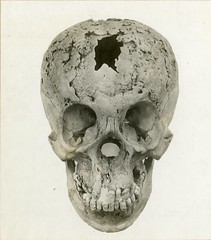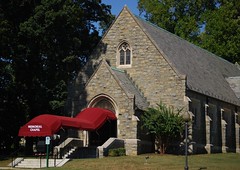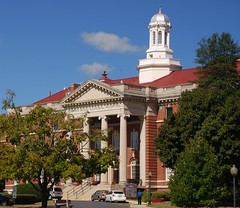André B. Sobocinski, the Deputy Historian/ Publications Manager of the Office of the Historian of the Navy's Bureau of Medicine and Surgery (BUMED) has a new issue of The Grog Ration newsletter about medical naval history out now.
The table of contents:
Page 1: Care Amidst the Shortage: The Relationship between the American Red Cross and the Navy Nurse Corps in World War I by Jennifer Telford, RN, PhD
When the United States declared war on 6 April 1917, the nation had but a nucleus of an army and a navy. The swift growth of the number of troops within a year from 100,000 to 4 million men presented a problem of enormous magnitude to the nursing profession; it was a shortage of epic proportions. The Army Nurse Corps had a mere 400 nurses on active duty, while the Navy had 160. The need for a rapid expansion of nursing in wartime to provide care both on the home-front and overseas brought about a controversy over who, in fact, was qualified to serve. The role of Katrina Hertzer, the liaison officer between the Red Cross Nursing Service and the Navy Nurse Corps, and who aided in the enrollment of nurses into the Corps, is of particular interest.
Nursing leaders during World War I debated about whether or not minimally trained nurses' aides should be recruited to help offset the professional nursing shortage. The result was the formation of an Army School of Nursing and the enrollment of volunteer nurses' aides into the Red Cross. The recruitment of nurses' aides to offset the nursing shortage of the World War I era was a logical solution to meeting the needs for nursing personnel. Whether or not this action compromised the status of nursing as a profession is still a matter of interest.
This article is adapted from lectures given at the Society for the History of Navy Medicine (SHNM) session in Rochester, NY, and as part of the Surgeon General's Speaker Series (SGSS) in Bethesda, MD, in April 2008. A PowerPoint of her SHNM lecture can be found at http://www.history-navy-med.org/home.html. A video of her SGSS lecture can be accessed at http://www.health.mil.
Page 7: Elvis Has Boarded the Ship
In 1958, LTJG Julia Pickering was one of two Navy nurses serving aboard the troop transport USS General Randall (AP-115) in port at Brooklyn, NY. Also on board this ship was a newly enlisted Army sergeant who had already established his name as an American pop icon. In a 2004 interview with the Office of the Historian, Pickering remembered this special passenger.
Page 8: The Surgeon's Log: Navy Medicine in Washington, DC
In 1908 a young hospital apprentice named Albert B. Montgomery reported for duty at the Naval Hospital, Washington, DC, then located on old "Observatory Hill" in Foggy Bottom. Years later he looked back upon his experiences-from racing horse-driven ambulances on cobblestone streets to obtaining study specimens at the city morgue for Naval Medical School students.
Page 11: Scuttlebutt
Find out about the upcoming Navy medical events (e.g., film premieres and lectures).
Page 12: Navy Medical Quiz
Good luck on this issue's quiz. As always, the first person to submit correct answers to all questions will receive a special prize. The answers from our previous quiz can be found on page 13.
An unofficial blog about the National Museum of Health and Medicine (nee the Army Medical Museum) in Silver Spring, MD. Visit for news about the museum, new projects, musing on the history of medicine and neat pictures.
Thursday, May 15, 2008
Wednesday, May 14, 2008
Tried and True Always Works
Since I've been away from the blog for a while, I thought I would work back into the swing of things with a plethora of links, a panoply of bloggy goodness for you to behold. Enjoy.
- Two offerings from our awesome friend Joanna at Morbid Anatomy: A few photos from her visit to the Musée Dupuytren in Paris (France, not Texas) with links of her own to follow; and vintage photos of med students with their cadavers. Both posts - worth it.
- Street Anatomy points us toward the Skull-A-Day project. I love it when blog titles exactly capture what their posts feature.
- And from pathtalk, a blog about pathology, is a link to a video that is beautiful and cool, but beyond me technically. The blog post - Animated DNA - and this bit of description 'incredibly cool animation of the central dogma of molecular biology' - offer some more clues. I watched it, I liked it, and think you might, too.
- And how about these very pretty pictures of surgical instruments, demonstrating that artistry can be found in anything and anywhere. Check out the post from something called SurgeXperiences. Who knew there was a blog carnival about surgical stuff? (And could that be less technical? "Surgical stuff"?)
Wounded Warrior Project


The Wounded Warrior Project and the Wounded Warrior Disabled Sports Project are two initiatives to help injured soldiers from Irag, Afghanistan, and the Global War on Terrorism return to life stateside, to give them a place and the means to recover their bodies, minds, and spirits. Two of their vans were on campus recently.
My husband is a Vietnam vet who has told of the reception he and his fellows received on their return (and who hasn't?), and it does my heart good to see the support our newest vets are getting.
Welcome home, soldiers.
Save the Date! Leprosy documentary and talk at NMHM, Thurs., 5/22
Save the Date! Leprosy documentary and talk at NMHM, Thurs., 5/22, 11:30am-1:00 p.m.
Enjoy a special lunchtime screening of the documentary 'Triumph at Carville: A Tale of Leprosy in America' at the National Museum of Health and Medicine, featuring a brief introduction by the filmmakers John Wilhelm and Sally Squires. (Film running time: approximately 58 minutes.) While at the Museum, check out the temporary exhibition highlighting the story of the country's only national leprosarium and
learn more about leprosy (also called Hansen's disease) and the unique social and cultural life at Carville. More online at http://www.nmhm.washingtondc.museum/exhibits/triumphatcarville/index.html.
Date: Thursday, May 22, 2008
Time: 11:30 a.m. - 1:00 p.m.
Where: Russell Auditorium at NMHM/AFIP (Bldg 54/Walter Reed Army Medical Center)
Cost: FREE! (Bring a bag lunch.)
Questions? Email nmhminfo@afip.osd.mil or visit the Museum online at http://www.nmhm.washingtondc.museum.
Enjoy a special lunchtime screening of the documentary 'Triumph at Carville: A Tale of Leprosy in America' at the National Museum of Health and Medicine, featuring a brief introduction by the filmmakers John Wilhelm and Sally Squires. (Film running time: approximately 58 minutes.) While at the Museum, check out the temporary exhibition highlighting the story of the country's only national leprosarium and
learn more about leprosy (also called Hansen's disease) and the unique social and cultural life at Carville. More online at http://www.nmhm.washingtondc.museum/exhibits/triumphatcarville/index.html.
Date: Thursday, May 22, 2008
Time: 11:30 a.m. - 1:00 p.m.
Where: Russell Auditorium at NMHM/AFIP (Bldg 54/Walter Reed Army Medical Center)
Cost: FREE! (Bring a bag lunch.)
Questions? Email nmhminfo@afip.osd.mil or visit the Museum online at http://www.nmhm.washingtondc.museum.
Armed Forces signs at Walter Reed
I spent a few lunch times last fall walking around Walter Reed, taking pictures of bumper stickers and other means of making statements. This is one of my favorites, if you can call it that. I think this is a touching tribute to a man who was obviously much loved and missed.
Tuesday, May 13, 2008
New National Library of Medicine exhibit
Manon Parry sent out an email about her new exhibit:
The National Library of Medicine (NLM), the world's largest medical library and a component of the National Institutes of Health (NIH), recently launched a new exhibition, "Against the Odds: Making a Difference in Global Health." The exhibition will be on display at the NLM on the outskirts of Washington DC until 2010, and can be viewed online at: http://apps.nlm.nih.gov/againsttheodds//index.cfm
The exhibition explores aspects of the history of global health as well as current issues, highlighting the shared concerns of communities around the world. Materials from the History of Medicine Division of the National Library of Medicine are on display alongside artifacts and images gathered from across the globe and video interviews. Featured stories include the early years of the AIDS epidemic in the United States and the work of ACT UP (the AIDS Coalition to Unleash Power), the
Chinese barefoot doctor movement, the International Campaign to Ban Landmines, and the smallpox eradication program led by the World Health Organization.
Alongside scientific discoveries and ongoing challenges, the stories illustrate the importance of clean water, safe housing, nutritious food, affordable healthcare, and protection from violence in fostering health and wellbeing. Visitors to the exhibition web site are invited to share their perspectives on these issues and GET INVOLVED: http://apps.nlm.nih.gov/againsttheodds/get_involved/index.cfm
The National Library of Medicine (NLM), the world's largest medical library and a component of the National Institutes of Health (NIH), recently launched a new exhibition, "Against the Odds: Making a Difference in Global Health." The exhibition will be on display at the NLM on the outskirts of Washington DC until 2010, and can be viewed online at: http://apps.nlm.nih.gov/againsttheodds//index.cfm
The exhibition explores aspects of the history of global health as well as current issues, highlighting the shared concerns of communities around the world. Materials from the History of Medicine Division of the National Library of Medicine are on display alongside artifacts and images gathered from across the globe and video interviews. Featured stories include the early years of the AIDS epidemic in the United States and the work of ACT UP (the AIDS Coalition to Unleash Power), the
Chinese barefoot doctor movement, the International Campaign to Ban Landmines, and the smallpox eradication program led by the World Health Organization.
Alongside scientific discoveries and ongoing challenges, the stories illustrate the importance of clean water, safe housing, nutritious food, affordable healthcare, and protection from violence in fostering health and wellbeing. Visitors to the exhibition web site are invited to share their perspectives on these issues and GET INVOLVED: http://apps.nlm.nih.gov/againsttheodds/get_involved/index.cfm
Saturday, May 10, 2008
Hirschhorn v. Army Medical Museum
Forty years ago, the Army Medical Museum was sent off the National Mall and its red brick building torn down to make space for the Hirschhorn Museum of modern art. Today's NY Times has an article, "An Identity Crisis? Hirshhorn Embraces It," By RANDY KENNEDY, May 10, 2008, which says, "...of the Hirshhorn’s 750,000 or so annual visitors, 58 percent reported being there for the first time. Sixty-four percent said they were at the museum as part of an adult group tour, following an itinerary that probably reflected little individual choice and low interest in contemporary art."
What's particular of interest in that statement is that in 1963, the Army Medical Museum had a similar number of visitors, while interest in museums and visitors to them has grown exponentially in Washington since then. Naturally our numbers on a guarded Army base five miles north of the Mall and a mile from a subway are in no way compatible. One does wonder how many people a National Museum of Health & Medicine on the Mall would be bringing in; I'm positive it would be more than the number we did in 1963 and that the Hirshhorn is doing now.
What's particular of interest in that statement is that in 1963, the Army Medical Museum had a similar number of visitors, while interest in museums and visitors to them has grown exponentially in Washington since then. Naturally our numbers on a guarded Army base five miles north of the Mall and a mile from a subway are in no way compatible. One does wonder how many people a National Museum of Health & Medicine on the Mall would be bringing in; I'm positive it would be more than the number we did in 1963 and that the Hirshhorn is doing now.
Anatomical Theatre website launches
Morbid Anatomy's launched a new site based on an exhibit of photographs she's done. She writes "I have finally launched the website for Anatomical Theatre, the photographic exhibition of medical museum artifacts. For more information about the project, check out the "Introduction" and "Press Release" pages."
Wax and plaster models as well as other specimens from the NMHM are included.
Wax and plaster models as well as other specimens from the NMHM are included.
Friday, May 9, 2008
Lecture on The Early History of NIH Biomedical Computing
This is at NIH.
Lecture: The Forgotten Revolution: The Early History of NIH Biomedical Computing
History of Biomedicine Lecture at the NIH May 16, 2008, 3:30 p.m.
Building 10 (Clinical Center), Room: Hatfield 2-3750
Dr. Joseph A. November, Ph.D., will present the 2008 DeWitt Stetten, Jr. Lecture, titled "The Forgotten Revolution: The Early History of NIH Biomedical Computing," on Friday, May 16 at 3:30 p.m., in Building 10 (Clinical Center), Room 2-3750 (Hatfield side). All are welcome.
About the Speaker:
Dr. November is the current DeWitt Stetten, Jr. Memorial Fellow and an Assistant Professor at the University of South Carolina's Department of History. He received his doctorate in history from Princeton University in 2006. At NIH his research focuses on how NIH promoted the development of computer technology in the 1950s and 1960s. He is preparing a book on the early history of biomedical computing.
Abstract:
At NIH today, digital electronic computers are a vital, necessary component of almost all aspects of research and administration. However, there was nothing inevitable about NIH's adoption of computers or the ways the machines came to be used. As late as 1956, the majority of NIH's leadership was firmly against dedicating resources to computing in research. It took a hard-fought campaign throughout the late 1950s and
early 1960s, led by Drs. Frederick Brackett and Arnold "Scotty" Pratt, and supported by Director James Shannon, to overcome NIH's reluctance to adopt the new technology.
The campaign bring computers to NIH may be long forgotten, but its consequences profoundly altered not only biomedical computing beyond the NIH campus but also computing in general.
This lecture will cover three interconnected stories. First, it will examine how the Division of Computer Research and Technology (now CIT) grew out of Brackett and Pratt's long struggle to computerize research at NIH. Second, it surveys the far-reaching activities of the Advisory Committee on Computers in Research (NIH-ACCR), which was established in 1960 and generously funded by the U.S. Senate for the purpose of introducing computers to laboratories and hospitals worldwide. Third, it describes NIH's important but seldom-discussed role in the development
of the Laboratory Instrument Computer (LINC), a small, general-purpose, real-time digital computer built in 1963 at MIT especially for biomedical researchers; the roots of many aspects of personal computing can be traced back to the LINC.
This presentation is sponsored by the Office of NIH History. The NIH Biomedical Computing Interest Group (BCIG) will be recording the lecture. For more information about the Biomedical Research History Interest Group (BRHIG) and upcoming events, please visit the websites at http://history.nih.gov or http://www.nih.gov/sigs/brhig.
NIH Visitor information:
See http://www.nih.gov/about/visitorsecurity.htm and
http://parking.nih.gov/visitor_access_map.htm.
For more information or special accommodations, please contact Deborah
Kraut at 301-496-8856 or krautd@mail.nih.gov.
Lecture: The Forgotten Revolution: The Early History of NIH Biomedical Computing
History of Biomedicine Lecture at the NIH May 16, 2008, 3:30 p.m.
Building 10 (Clinical Center), Room: Hatfield 2-3750
Dr. Joseph A. November, Ph.D., will present the 2008 DeWitt Stetten, Jr. Lecture, titled "The Forgotten Revolution: The Early History of NIH Biomedical Computing," on Friday, May 16 at 3:30 p.m., in Building 10 (Clinical Center), Room 2-3750 (Hatfield side). All are welcome.
About the Speaker:
Dr. November is the current DeWitt Stetten, Jr. Memorial Fellow and an Assistant Professor at the University of South Carolina's Department of History. He received his doctorate in history from Princeton University in 2006. At NIH his research focuses on how NIH promoted the development of computer technology in the 1950s and 1960s. He is preparing a book on the early history of biomedical computing.
Abstract:
At NIH today, digital electronic computers are a vital, necessary component of almost all aspects of research and administration. However, there was nothing inevitable about NIH's adoption of computers or the ways the machines came to be used. As late as 1956, the majority of NIH's leadership was firmly against dedicating resources to computing in research. It took a hard-fought campaign throughout the late 1950s and
early 1960s, led by Drs. Frederick Brackett and Arnold "Scotty" Pratt, and supported by Director James Shannon, to overcome NIH's reluctance to adopt the new technology.
The campaign bring computers to NIH may be long forgotten, but its consequences profoundly altered not only biomedical computing beyond the NIH campus but also computing in general.
This lecture will cover three interconnected stories. First, it will examine how the Division of Computer Research and Technology (now CIT) grew out of Brackett and Pratt's long struggle to computerize research at NIH. Second, it surveys the far-reaching activities of the Advisory Committee on Computers in Research (NIH-ACCR), which was established in 1960 and generously funded by the U.S. Senate for the purpose of introducing computers to laboratories and hospitals worldwide. Third, it describes NIH's important but seldom-discussed role in the development
of the Laboratory Instrument Computer (LINC), a small, general-purpose, real-time digital computer built in 1963 at MIT especially for biomedical researchers; the roots of many aspects of personal computing can be traced back to the LINC.
This presentation is sponsored by the Office of NIH History. The NIH Biomedical Computing Interest Group (BCIG) will be recording the lecture. For more information about the Biomedical Research History Interest Group (BRHIG) and upcoming events, please visit the websites at http://history.nih.gov or http://www.nih.gov/sigs/brhig.
NIH Visitor information:
See http://www.nih.gov/about/visitorsecurity.htm and
http://parking.nih.gov/visitor_access_map.htm.
For more information or special accommodations, please contact Deborah
Kraut at 301-496-8856 or krautd@mail.nih.gov.
Wednesday, May 7, 2008
Reeve233
This has been a pretty big hit over the last couple of days, so we figure some blog must have linked to it. The wages of sin, y'all.
Chapel at Walter Reed
The Memorial Chapel is on the Walter Reed campus. It was built with funds raised by the Gray Ladies of the Red Cross Hospital Service and was dedicated in 1931 as a memorial to those who gave their lives in the service of their country. (The Gray Ladies were so called because of the gray uniform they wore.) The first ceremony performed was a wedding. Sunday services are still held there, and I saw funeral services being organized there last week.
It's a lovely place, inside and out.
Here's a picture of the stained glass window over the altar:
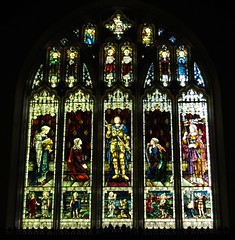
There are "gargoyles" at the top of the tower. Some of them represent the Gray Ladies:
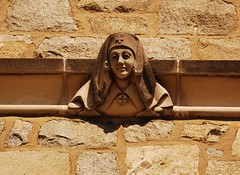
and there are others that represent science and religion. Not sure which one this is.
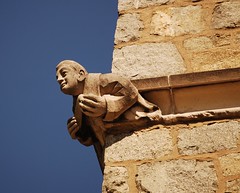
It's a lovely place, inside and out.
Here's a picture of the stained glass window over the altar:

There are "gargoyles" at the top of the tower. Some of them represent the Gray Ladies:

and there are others that represent science and religion. Not sure which one this is.

Old Walter Reed Hospital
As you may know, our museum is on the campus of the Walter Reed Army Medical Center in Washington DC. I bought myself a spiffy new camera last fall and have been a picture-taking fool since then. This picture is of the original hospital, opened in 1909. Stately, isn't it? It was replaced with a, um, not-as-nice-looking building in the 1970s and this one's now used for administrative offices.
Monday, May 5, 2008
Yahoo on TV diseases
Yahoo's got a fun feature on whether or not TV diseases are fact or fiction. I've seen and enjoyed House, but probably not any of the other shows - it doesn't matter though. Disease of the week tv has been around for years.
Regarding slide 3 - FOP - you can see an example at the Mutter Museum.
Regarding slide 3 - FOP - you can see an example at the Mutter Museum.
The Washington Society for the History of Medicine wants you!
Print this out, fill it out and mail it to Judy.
Washington Society for the History of Medicine
Membership Form 2008
NAME: ___________________________________________________________
ADDRESS: ________________________________________________________
CITY: _____________________________________________________________
STATE: _________________________ ZIP CODE: ___________________
TELEPHONE: ____________________________Work_____ or Home_____
EMAIL ADDRESS: __________________
AFFILIATION: ____________________________________________________
MEMBERSHIP CATEGORIES:
STANDARD: $15.00 __________
SPONSOR: $25.00 __________
STUDENT: $10.00 __________
Dear WSHM Member
Please make your checks payable to the WSHM. Mail your membership dues and this form to: Judy M. Chelnick, Secretary-Treasurer, WSHM, 4868 Cloister Drive, Rockville, Maryland 20852 Thank You!
Check out our Website: http://wshmdc.blogspot.com/
Washington Society for the History of Medicine
Membership Form 2008
NAME: ___________________________________________________________
ADDRESS: ________________________________________________________
CITY: _____________________________________________________________
STATE: _________________________ ZIP CODE: ___________________
TELEPHONE: ____________________________Work_____ or Home_____
EMAIL ADDRESS: __________________
AFFILIATION: ____________________________________________________
MEMBERSHIP CATEGORIES:
STANDARD: $15.00 __________
SPONSOR: $25.00 __________
STUDENT: $10.00 __________
Dear WSHM Member
Please make your checks payable to the WSHM. Mail your membership dues and this form to: Judy M. Chelnick, Secretary-Treasurer, WSHM, 4868 Cloister Drive, Rockville, Maryland 20852 Thank You!
Check out our Website: http://wshmdc.blogspot.com/
Sunday, May 4, 2008
More medical technology - robot-assisted surgery
Here's an interesting bit about robot surgery - which saves wear-and-tear on both the surgeon and the patient when everything goes right. In the Museum, we have a Satava collection devoted to collecting the groundbreaking medical technology mentioned in the article, and on display we have Penelope, a early attempt at a robot nurse.
Prepping Robots to Perform Surgery
By BARNABY J. FEDER
New York Times May 4, 2008
From knees to the heart, more operations are being performed by robots, under the guidance of surgeons.
Prepping Robots to Perform Surgery
By BARNABY J. FEDER
New York Times May 4, 2008
From knees to the heart, more operations are being performed by robots, under the guidance of surgeons.
Gastric bypass surgery for diabetes?
An exciting new possibility for the treatment (and cure!) of diabetes was reported in today's Washington Post. Trials are being conducted around the world with surprisingly successful results in not just making the disease more manageable but an actual cure. The guess is that the surgery, which removes part of the small intestine, "alter[s] the elixir of hormones secreted by the digestive system to regulate hunger, store energy and influence other physiological functions, helping restore the body's system for controlling blood sugar with insulin." Keep your fingers crossed.
Saturday, May 3, 2008
Museo Storico Nazionale Dell Arte Sanitaria (I think this means something along the lines of Medical Museum), in Rome

A couple of years ago, when the dollar was still showing signs of life against the euro, my husband and I took a trip to Italy. While we were in Rome, we made a quick visit to the Museo Storico Nazionale Dell Arte Sanitaria. Being an American and therefore not speaking/reading/writing any language other than English made for an interesting visit in that in many cases I couldn't quite decipher the labels on the exhibits and to do a significant amount of guessing. Here's one I just didn't get at all, no matter the amount of puzzling over the label I did. My husband's take: a labor-inducing machine for those recalcitrant babies who don't want to ease on out on their own.
Friday, May 2, 2008
Teddy Roosevelt and The River of Doubt
Several months ago we had a researcher in the archives whose name seemed vaguely familiar to me but I just couldn't place it. Some time after she'd finished with us I started reading a book about Teddy Roosevelt's exploration of the Amazon after he'd been defeated as a presidential third-party candidate in 1912, a journey that turned into a nightmare and on which he nearly lost his life. Nudge, nudge in my brain about the author's name and the next day I checked our visitor log. Sure enough, the same woman: Candice Millard. This was a fantastic book, utterly gross at times (such as tiny - and I think barbed - fish that travel up a urine stream to the bladder much as a salmon travels upstream, and you don't want to hear how it has to be removed) but I highly recommend it. I can't wait for her next book to come out.
Thursday, May 1, 2008
Japanese anatomical drawings
These incredible early 19th century Japanese anatomical drawings reveal a remarkable distinctively non-Western approach to anatomical illustration.
Subscribe to:
Posts (Atom)

